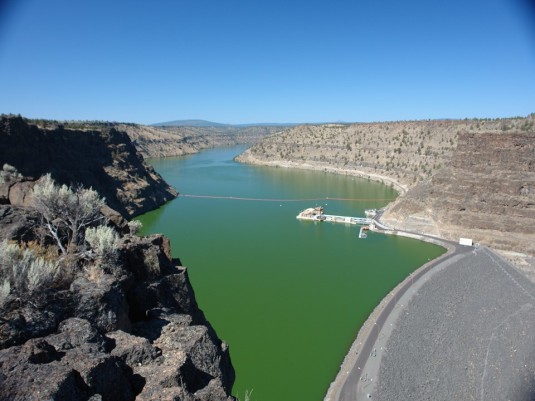Likely in response to concerns raised by DRA, PGE contracted a two-year study on water quality and algae in beginning 2015. Results of the study were initially published in summer of 2019.
The 2019 study included analysis of data collected from the tributaries into Lake Billy Chinook, Lake Simtustus and the lower Deschutes River. A primary finding was that the Crooked River is the main source of nitrogen that leads to nuisance algae growth in the reservoirs and the lower river downstream from the dams. Crooked River water enters the Round Butte Dam’s forebay (the location of the Selective Water Withdrawal Tower) at a relatively shallow depth and mixes minimally with the Metolius River water entering at the bottom of the forebay. As a consequence, surface water in the forebay is primarily Crooked River water, rich in fertilizer runoff and cattle waste (and possibly agricultural pesticides) from the Crooked River basin.

During about nine months of the year PGE utilizes the SWW Tower to discharge primarily surface water from Lake Billy Chinook. This heavily contaminated water is run through the power generating turbines and discharged into the lower Deschutes.
This selective discharge of surface water imposes the single largest impact PGE operation of the SWW Tower has had on water quality below the dam complex. It has led to immediate and ongoing negative changes in the biology and ecology of the lower river that can be traced back to the start of SWW Tower operations.
After the study results were made public, PGE’s contractor discovered that errors in the periphyton analysis had been made. The sub-contracting lab that did the original algae identification reanalyzed the abundance counts and biovolume measures and found large errors in four species of algae in the lower Deschutes River.
We’ve not heard why this report failed to reconcile its algae findings with the earlier R2 report on macroinvertebrates and periphyton growth.
The new data resulted in some reanalysis by PGE’s contractor and new interpretations of what the findings meant were offered. In reality though, none of this changes anything fundamental about the study, which PGE reissued this month, nor its findings. The single most important result of remains that no matter what species of algae are dominant in the lower Deschutes in the post SWW-Tower years, the cause of the increase in algae remains nutrient enrichment caused by SWW Tower operation.
The present set of releases shows once again a troubling trend with PGE’s ability to bring studies to an accurate completion. The now famously flawed – as determined by ODEQ – PGE-R2 aquatic insect and algae study also required a major reanalysis and revision due to the use of inappropriate statistical methods, a failing brought to light by DRA. Our report is available at this link.

PGE’s issues with accurate scientific conclusions here come in the larger context of its scientifically unsound and completely unsuccessful fish reintroduction experiment. Thirteen years after the first juvenile reintroduction fish were released into upstream tributaries, as the graph below shows, adult returns can only be called a failure. All the while in this post-SWW Tower world, pollution-laden Lake Billy Chinook surface water is passed into the lower Deschutes in an attempt to make possible this failing program. PGE repeatedly says, “We need more time.” How much time and what is needed to achieve success are never specified.
We have a very different lower Deschutes River (and not in a good way) and a failing reintroduction effort to show for it. There, that’s the real bottom line. And it didn’t take a multi-year study to figure that out!

